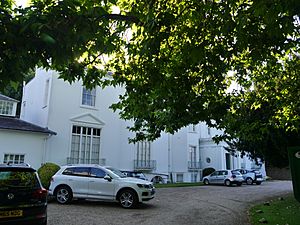Richardson Evans facts for kids
Richardson Evans (born April 5, 1846 – died May 10, 1928) was an important British civil servant, journalist, and writer. He is best known for working to protect natural beauty and control too much advertising.
Evans worked for the British government in India from 1867 to 1876. He was part of the Indian Civil Service in an area called the North-Western Provinces. After that, he moved back to London and became a journalist, writing for newspapers and magazines.
Contents
Fighting for Natural Beauty
From the 1880s, Richardson Evans became a champion for protecting beautiful places. He was worried about how advertising signs were popping up everywhere and spoiling the views.
Stopping Ugly Advertising
Evans strongly believed that advertising should not ruin natural landscapes. He campaigned to stop large advertisements from being placed along railway lines. He also worked to save the famous view of the River Thames from Richmond Hill in London.
In 1890, he wrote an article called "The Age of Disfigurement" in a magazine called the National Review. In this article, he argued that many posters and advertising signs were ugly and annoying. He thought that the more annoying an ad was, the more people noticed it.
Evans wanted rules to control advertising. He believed local councils should be able to protect beautiful or important places from being spoiled by ads. He also suggested taxing posters and even boycotting (refusing to buy) products that were advertised in an offensive way.
Founding the Scapa Society
Richardson Evans was a key person in starting the Scapa Society. This group's full name was the Society for Checking the Abuses in Public Advertising. It was the very first organized group to fight against ugly advertising.
Local Community Work
Richardson Evans lived in a house called The Kier, which was near Wimbledon Common in London. He was very involved in his local community.
The Wimbledon Society
In 1903, Evans was the main founder of the John Evelyn Club. This club is now known as the Wimbledon Society. He worked as its secretary, helping to run the club, until 1920. The Wimbledon Society works to protect and improve the local area.
Wimbledon Choral Society
Evans also helped start the Wimbledon 1914 Choral Society. This group, now called the Wimbledon Choral Society, is a choir that sings together. He was their first president until 1919.
Memorials and Legacy
Richardson Evans's work to protect natural beauty is remembered in several ways.
Richardson Evans Memorial Playing Fields
The Richardson Evans Memorial Playing Fields (REMPF) are named in his honor. These playing fields are located at Putney Vale, right next to Wimbledon Common. There is a war memorial within the playing fields, designed in 1921. Part of its inscription says, "Nature provides the best memorial."
Owler Tor Memorial
There is also a special memorial plaque on Owler Tor, a viewpoint in the Peak District National Park. The plaque says: "This viewpoint and 25 acres around forming part of the Longshaw Estate are given in memory of Richardson Evans 1846–1928." It also includes a quote from "The Children’s Song" by the famous writer Rudyard Kipling.
In 1931, when the Longshaw Estate was given to the National Trust (a charity that protects special places), it was reported that Evans's widow had given £500. She did this so that his name would be connected with the estate, remembering his important work in preserving natural beauty.


